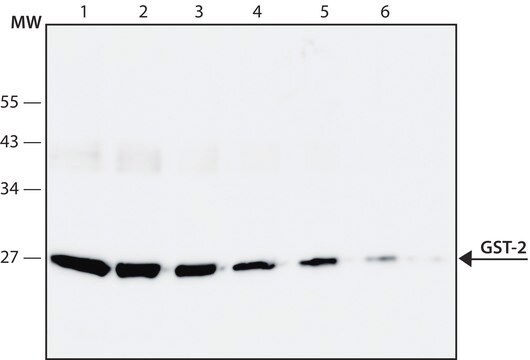Wszystkie zdjęcia(1)
Kluczowe dokumenty
GS71
GST K1-1, Recombinant Human
Synonim(y):
GST, GST 13-13, GST13, GST13-13, GSTK1-1, glutathione S-transferase kappa, hGSTK1
Zaloguj sięWyświetlanie cen organizacyjnych i kontraktowych
About This Item
Kod UNSPSC:
12352200
NACRES:
NA.26
Polecane produkty
pochodzenie biologiczne
human
Poziom jakości
rekombinowane
expressed in E. coli
Próba
>95% (SDS-PAGE)
Postać
frozen liquid
aktywność właściwa
12.22 units/mg protein
masa cząsteczkowa
26 kDa
stężenie
3.17 mg/mL
temp. przechowywania
−70°C
informacje o genach
human ... GSTK1(373156)
Opis ogólny
using spectrophotometric determination of 1-chloro-2,4-dinitrobenzene (CDNB) conjugation with reduced glutathione (1 mM) in 100 mM NaPO4 (pH 6.5) at room temperature.
Działania biochem./fizjol.
Glutathione S-transferase kappa 1 (GSTK1) is an enzyme that in humans is encoded by the GSTK1 gene. Glutathione S-transferases (GSTs) are a family of enzymes that play an important role in detoxification by catalyzing the conjugation of many hydrophobic and electrophilic compounds with reduced glutathione. Based on their biochemical, immunologic, and structural properties, cytosolic and membrane-bound forms of glutathione S-transferase are encoded by two distinct supergene families. At present, eight distinct classes of the soluble cytoplasmic mammalian glutathione S-transferases have been identified: alpha, kappa, mu, omega, pi, sigma, theta and zeta. The GSTs are thought to function in xenobiotic metabolism and play a role in susceptibility to cancer, and other diseases.
This gene encodes a member of the kappa class of the glutathione transferase superfamily of enzymes that function in cellular detoxification. The encoded protein is localized to the peroxisome and catalyzes the conjugation of glutathione to a wide range of hydrophobic substates facilitating the removal of these compounds from cells. Alternative splicing results in multiple transcript variants.
Przechowywanie i stabilność
The enzyme should be used by the end-user customer within 1 year of receipt.
Ta strona może zawierać tekst przetłumaczony maszynowo.
Kod klasy składowania
10 - Combustible liquids
Klasa zagrożenia wodnego (WGK)
WGK 1
Temperatura zapłonu (°F)
Not applicable
Temperatura zapłonu (°C)
Not applicable
Certyfikaty analizy (CoA)
Poszukaj Certyfikaty analizy (CoA), wpisując numer partii/serii produktów. Numery serii i partii można znaleźć na etykiecie produktu po słowach „seria” lub „partia”.
Masz już ten produkt?
Dokumenty związane z niedawno zakupionymi produktami zostały zamieszczone w Bibliotece dokumentów.
E V Kalinina et al.
Bulletin of experimental biology and medicine, 154(1), 64-67 (2013-01-19)
We studied the expression of genes encoding glutathione-S-transferase isoforms GSTP1-1, GSTA4-4, and GSTK1-1 during the development of the resistance of human erythroleukemia (K562), mammary adenocarcinoma (MCF-7) and ovary adenocarcinoma (SKOV-3) cells to cisplatin (CDDP). It was found that drug resistance
Anna Robinson et al.
The Biochemical journal, 379(Pt 3), 541-552 (2004-01-08)
The Kappa class of GSTs (glutathione transferases) comprises soluble enzymes originally isolated from the mitochondrial matrix of rats. We have characterized a Kappa class cDNA from human breast. The cDNA is derived from a single gene comprising eight exons and
Jie Li et al.
Protein science : a publication of the Protein Society, 14(9), 2361-2369 (2005-08-06)
Glutathione transferases (GSTs) are a superfamily of enzymes that play a vital functional role in the cellular detoxification process. They catalyze the conjugation of the thiol group of glutathione (GSH) to the electrophilic groups of a wide range of hydrophobic
Fabrice Morel et al.
The Journal of biological chemistry, 279(16), 16246-16253 (2004-01-27)
Kappa class glutathione S-transferase (GST) cDNA sequences have been identified in rat, mouse, and human. In the present study, we determined the structure and chromosomal location of the human GST Kappa 1 (hGSTK1) gene, characterized the protein, and demonstrated its
Nasz zespół naukowców ma doświadczenie we wszystkich obszarach badań, w tym w naukach przyrodniczych, materiałoznawstwie, syntezie chemicznej, chromatografii, analityce i wielu innych dziedzinach.
Skontaktuj się z zespołem ds. pomocy technicznej